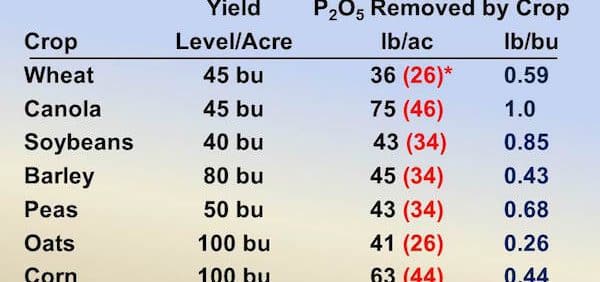Canola needs 1.25 to 1.5 pounds of phosphate per bushel of yield and removes 67% of that in the harvested seed.
Canola removes more phosphate than other crops, and studies show that phosphate fertilizer rates have lagged crop removal for years. The result, says soil fertility expert Ross McKenzie, is that about 80% of Prairie fields are deficient in phosphorus. Those fields are likely to show a yield response to phosphate fertilizer.
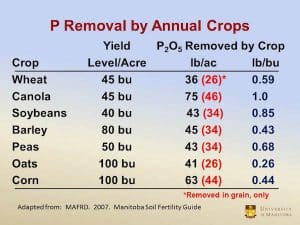
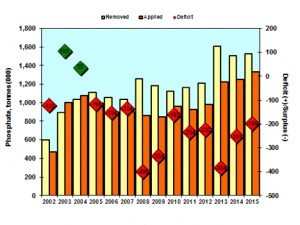
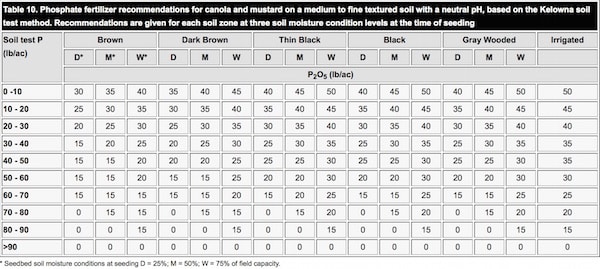
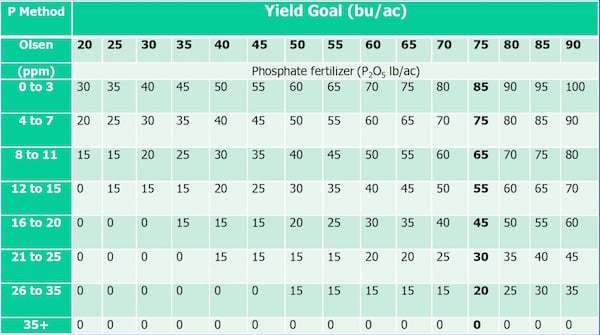
1. Soil tests
Recommended soil tests are Modified Kelowna for Alberta and Olsen (sodium bicarbonate or “bicarb”) for Manitoba. Both tend to be used in Saskatchewan. Other tests are not calibrated for Prairie soils and should not be used to make P fertilizer recommendations for Western Canadian farms.
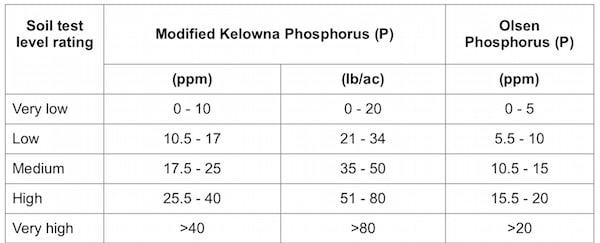
2. Rates
Farmers tend to follow one of these three philosophies when it comes to P fertilizer rates:
Sufficiency approach. Apply just enough to meet the bare minimum for yield, with the crop taking up the rest of what it needs from soil reserves and the labile pool. This can maximize net returns to fertilization in the year of application but will drain soil reserves. Once soil reserves are medium to low, this approach will hurt yields and profitability.
Removal approach. This aims to match application rate to expected crop removal based on yield targets. This will not build soil P amounts but should not reduce them either.
Build and Maintenance approach. Apply fertilizer P at rates in excess of crop removal to slowly increase soil P levels to an adequate level. In general, it takes 12-40 lb./ac. of phosphate to increase soil phosphate levels by 1 ppm using the Olsen method. The wide range reflects soil type. Research by Cindy Grant with AAFC showed it it took about 16 lb./ac. of P2O5 to raise soil P by 1 ppm on a slightly acidic sandy loam soil at Carman, Manitoba, but 30-40 lb./ac. on a calcareous clay loam soil at Brandon. If crop removal is 40 lb./ac., farmers would have to use a rate of 52-80 lb./ac. to satisfy removal and increase soil reserves by 1 ppm. This “building” approach can be used successfully with P as well as potassium because they are immobile nutrients and will remain in the soil if not used in the year of application.
Even for soil with high levels of phosphate, McKenzie recommends 15 lb./ac. of seed-placed phosphate for the pop-up benefit. However, once soil P levels are very high, he says phosphate fertilizer is not needed.
3. Product
Most phosphate fertilizer products will do the job. Whether monoammonium phosphate (11-52-0/12-51-0) or liquid polyphosphate (10-34-0), the key is to apply an amount of phosphate that matches crop removal or applied at a sufficiency level to ensure adequate P is available for optimum yield.
(Note of interest: In North America, the fertilizer analysis for P is actually based on the percentage of oxide form of phosphate (P2O5) in the product. MAP has 52% phosphate. In Europe, analysis for P is based on the elemental amount — just P — so analysis for the exact same MAP in Europe would be 11-23-0.)
Feedlot manure: A 40-ton-per-acre application of feedlot manure can provide about 600 lb./ac. of phosphate. Other manure sources could be even higher. Test manures to avoid over-application of phosphate. Soil with manure applications will often not require P fertilizer or potassium, sulphur and micronutrients for five years or more depending on application rates and type of manure applied.
4. Placement
Seed-placed rates should be no more than 15-20 lb./ac. phosphate. Dry conditions and light-textured soil increase risk of stand thinning from seed-placed fertilizer. Increased soil moisture lowers the risk to seedling injury. This rate also ensures all seeds are in fairly close proximity to phosphate prills or droplets. Put the rest in a side or mid-row band away from the seed row.
5. Deficiency symptoms
These are very difficult to identify with phosphorus. Often severely deficient fields don’t show any major outward symptoms. Growth rate and vigour are often stunted, but this only becomes obvious when compared side by side with plants that are not deficient. More from the Canola Encyclopedia.
